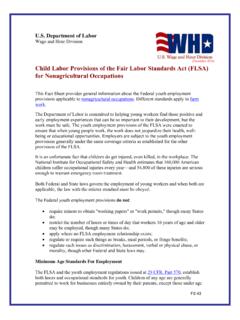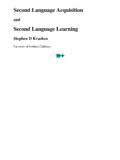Transcription of COSFORMER : RETHINKING SOFTMAX IN ATTENTION
1 Published as a conference paper at ICLR 2022. COS F ORMER : R ETHINKING S OFTMAX IN ATTENTION . 1. Zhen Qin 1,3 Weixuan Sun 1,4 Hui Deng 3 Dongxu Li 1 Yunshen Wei 1 Baohong Lv 1. Junjie Yan 2,5 Lingpeng Kong 1,2 Yiran Zhong . 1 2 3. SenseTime Research Shanghai AI Laboratory Australian National University 4 5. Northwestern Polytechnical University The University of Hong Kong A BSTRACT. [ ] 17 Feb 2022. Transformer has shown great successes in natural language processing, computer vision, and audio processing. As one of its core components, the SOFTMAX atten- tion helps to capture long-range dependencies yet prohibits its scale-up due to the quadratic space and time complexity to the sequence length. Kernel methods are often adopted to reduce the complexity by approximating the SOFTMAX operator. Nevertheless, due to the approximation errors, their performances vary in differ- ent tasks/corpus and suffer crucial performance drops when compared with the vanilla SOFTMAX ATTENTION .
2 In this paper, we propose a linear transformer called COS F ORMER that can achieve comparable or better accuracy to the vanilla trans- former in both casual and cross attentions. COS F ORMER is based on two key properties of SOFTMAX ATTENTION : i). non-negativeness of the ATTENTION matrix; ii). a non-linear re-weighting scheme that can concentrate the distribution of the at- tention matrix. As its linear substitute, COS F ORMER fulfills these properties with a linear operator and a cosine-based distance re-weighting mechanism. Extensive experiments on language modeling and text understanding tasks demonstrate the effectiveness of our method. We further examine our method on long sequences and achieve state-of-the-art performance on the Long-Range Arena benchmark. The source code is available at COS F ORMER . 1 I NTRODUCTION. 56. BigBird COSFORMER Transformer 54. Long-Range Arena Score Longformer Synthesizer Linformer 52.
3 Sinkhorn Transformer Reformer performer 50 Sparse Transformer Linear Transformer 48. 46 Local ATTENTION 20 30 40 50 60 70. Speed (examples per sec). Figure 1: Performance (y axis), speed (x axis), and memory footprint (circle sizes) of efficient transformers on the Long-Range Arena benchmark. The proposed COS F ORMER achieves an all-around supremacy over competing methods in the top left quadrant. With years of development, the transformer model (Vaswani et al., 2017) and its variants (Zaheer et al., 2020; Wang et al., 2020; Tay et al., 2020a) have been successfully adapted to three most popular artificial intelligence (AI) fields: , natural language processing (Devlin et al., 2019;. Liu et al., 2019), computer vision (Dosovitskiy et al., 2020; Carion et al., 2020; Liu et al., 2021). and audio processing (Schneider et al., 2019; Baevski et al., 2020). Compared with conventional.
4 Indicates the corresponding author. Indicates equal contribution. 1. Published as a conference paper at ICLR 2022. recurrent (Hochreiter & Schmidhuber, 1997) and convolutional architectures (He et al., 2016), transformer-based architectures are generally more scalable to data volumes (Brown et al., 2020). and stronger in capturing global information with less inductive bias, thus excelling on many tasks. Dot-product ATTENTION with SOFTMAX normalization is the cornerstone of the transformer to capture long-range dependencies. However, its quadratic space and time complexity with regard to the length of the sequence make its computational overhead prohibitive, especially for long inputs. To address this issue, numerous methods are proposed recently, such as the sparse ATTENTION matrix (Za- heer et al., 2020; Beltagy et al., 2020; Tay et al., 2020a; Kitaev et al., 2019; Child et al.)
5 , 2019),low- rank representations (Wang et al., 2020) or kernel-based methods (Peng et al., 2020; Choromanski et al., 2020; Katharopoulos et al., 2020), among many others. These methods achieve reduced computational complexity with comparable performances when compared with the vanilla ATTENTION architecture on several selected tasks or corpus. However, the improved efficiency is usually achieved via introducing additional yet often impracti- cal assumptions on the ATTENTION matrix (Wang et al., 2020) or with valid approximation of SOFTMAX operation only within constrained theoretical bounds (Choromanski et al., 2020; Peng et al., 2020). Therefore, when their assumptions are unsatisfied or when approximation errors get accumulated, these methods may not always be advantageous over the vanilla architecture (Narang et al., 2021). Consequently, performance deficiencies in a broad application spectrum are often observed in these transformer variants, especially those with linear complexity.
6 For example, the performer (Choro- manski et al., 2020), RFA (Peng et al., 2020) and Reformer (Kitaev et al., 2019) show less satis- factory performance on the GLUE benchmark (Wang et al., 2018) when compared with the vanilla architecture as suggested in our preliminary experiments (Tab. 2). Furthermore, many of these afore- mentioned methods are not applicable to casual attentions, which are critical for auto-regressive training. For example, techniques proposed in Linformer (Wang et al., 2020) and BigBird (Zaheer et al., 2020) are specific to cross attentions. Since the SOFTMAX operator appears to be the main hurdle while efficient yet accurate approximation to SOFTMAX is difficult to achieve, one question naturally arises: Can we replace the SOFTMAX opera- tor with a linear function instead, while maintaining its key properties? . By digging into the soft- max ATTENTION , we find two key properties that affect its empirical performance: (i) elements in the ATTENTION matrix are non-negative (Tsai et al.)
7 , 2019; Katharopoulos et al., 2020); (ii) the non-linear re-weighting scheme acts as a stabilizer for the ATTENTION weights (Titsias, 2016; Gao & Pavel, 2017;. Jang et al., 2016). These findings reveal some new insights of the current approaches. For example, the linear transformer (Katharopoulos et al., 2020) achieves property (i) using an exponential linear unit (Clevert et al., 2016) activation function. However, due to lack of the re-weighting scheme, it underperforms other efficient transformer variants on the Long-Range Arena benchmark as shown in Figure 1 as well as the language modeling task (Table 2) based on our controlled experiments. In this paper, we propose a new variant of linear transformer called COS F ORMER that satisfies both of the above properties. Specifically, we enforce the non-negative property by passing the features to a ReLU (Agarap, 2018) activation function before computing the similarity scores.
8 In this way, we encourage the model to avoid aggregating negatively-correlated contextual information. Further, we adopt a cos re-weighting scheme to stabilize the ATTENTION weights. This helps the model to amplify local correlations, which usually contain more relevant information for natural language tasks. Thanks to the Ptolemy's theorem, our ATTENTION can be exactly decomposed into a linear form. We perform extensive experiments on both autoregressive language models and bidirectional models on five public benchmarks, including WikiText-103 (Merity et al., 2017), GLUE (Wang et al., 2018), IMDB (Maas et al., 2011), AMAZON (Ni et al., 2019) and Long-Range Arena benchmark (Tay et al., 2020b). Our model shows much better inference speed and smaller memory footprint, while achieving on par performance with the vanilla transformer. It is noteworthy that our method ranks 1st on the Long-Range Arena benchmark, showing favorable performance than other competitors, which well demonstrates its strong capacity in modeling long sequence inputs.
9 2 O UR M ETHOD. In this section, we provide technique details of our linear transformer called COS F ORMER . The key insight of the COS F ORMER is to replace the non-decomposable non-linear SOFTMAX operation by a linear operation with decomposable non-linear re-weighting mechanism. Our model is applicable 2. Published as a conference paper at ICLR 2022. to both casual and cross attentions with a linear time and space complexity with regard to the input sequence length, thus exhibiting strong capacity in modeling long-range dependencies. T HE G ENERAL FORM OF T RANSFORMER. Given an input sequence x with length of N , we first represent it in the embedding space x RN d with feature dimension of d. A transformer block T : RN d RN d with input x is defined as: T (x) = F(A(x) + x), (1). where F is a feedforward network that contains a residual connection; A is the self- ATTENTION func- tion that computes the ATTENTION matrix A, which has quadratic space and time complexity with respect to N , thus becoming the computation bottleneck of T on long inputs.
10 There are three key components in A, namely, query (Q), key (K), value (V ) computed through three learnable linear matrices WQ , WK , WV : Q = xWQ , K = xWK , V = xWV . We use Mi to represent the i-th row of a matrix M , then the output O RN d of A(x) can be computed as: T. X S(Qi , Kj ). O = A(x) = [O1 , .. , ON ] , Oi = P Vj , (2). j j S(Qi , Kj ). where S( ) measures the similarity between queries. If S(Q, K) = exp(QK T ), the Eq. 2 becomes the dot-product ATTENTION with SOFTMAX normalization. In this case, the space and time complexity to compute one row of the output Oi is O(N ). Therefore, the total space and time complexity for computing O grows quadratically with respect to the input length. L INEARIZATION OF S ELF - ATTENTION . According to Eq. 2, we can select any similarity functions to compute the ATTENTION matrix. In order to maintain a linear computation budget, one solution is to adopt a decomposable similarity function such that: S(Qi , Kj ) = (Qi ) (Kj )T , (3).
![arXiv:0706.3639v1 [cs.AI] 25 Jun 2007](/cache/preview/4/1/3/9/3/1/4/b/thumb-4139314b93ef86b7b4c2d05ebcc88e46.jpg)

![arXiv:1301.3781v3 [cs.CL] 7 Sep 2013](/cache/preview/4/d/5/0/4/3/4/0/thumb-4d504340120163c0bdf3f4678d8d217f.jpg)
![@google.com arXiv:1609.03499v2 [cs.SD] 19 Sep 2016](/cache/preview/c/3/4/9/4/6/9/b/thumb-c349469b499107d21e221f2ac908f8b2.jpg)











